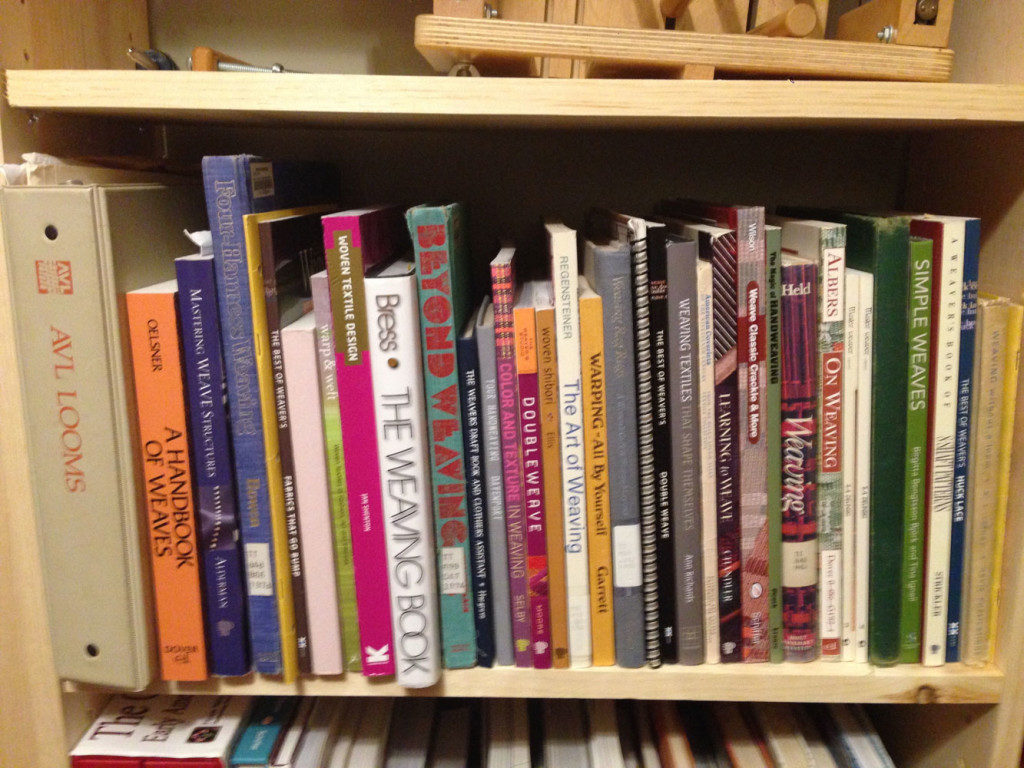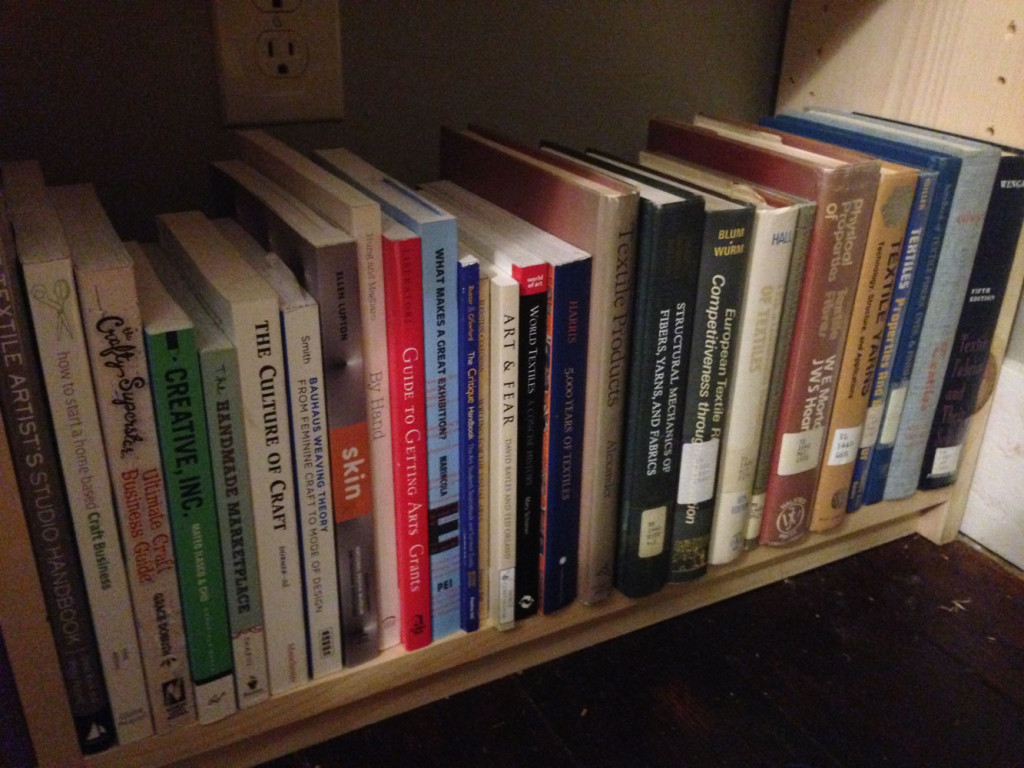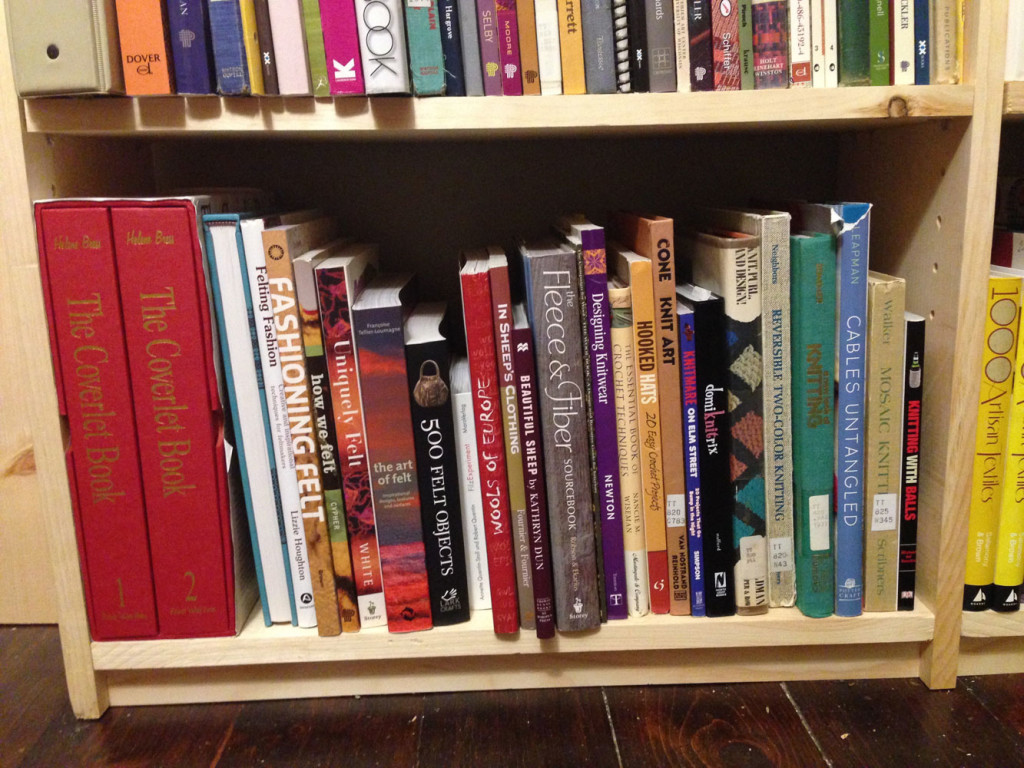I am a self-proclaimed bibliophile. I love being surrounded by books and the information they provide. Weaving literature in particular are very inspiring to have mixed in with my cones of yarn on my bookshelves. Before my husband built me these amazing bookshelves I have, I thought I had quite the extensive library of textile books. Upon collecting all of these books in one place, I came to the realization that I have a pretty small, but varied collection in regards to the different information they contain.

A little bit about my personal library: As I have progressed in my book collection, I have become more selective about what kind of information they need to have, and the overall presentation of the information (this is a side effect of being married to a Graphic Designer who is drawn to clean design). My book purchases have slowed down tremendously when I added the phrase "where is the value in this book?" when I hold it in my hands. What do I mean by this? The information that is presented in the book is going to add to my knowledge and help me grow as a designer and textile historian. Is the information going to help me solve problems, or does it add mystery to an already complicated craft. And will this book help me feel inspired to keep pushing the envelope in my weaving?

Other topics in my library
Craft Theory
My mind may not be able to 100% wrap around what the author is trying to express or explain- but the information from the books can help me develop my own design voice. Currently I am reading a Bauhaus Theory in regards the Feminism and Weaving Theory it is very dense and sometimes makes me frustrated BUT the information I am gaining from it is empowering me in my own aesthetics and to explore different avenues in my work.

History
This a large category which encompasses Craft, Textile, and Costume/Fashion History. I like to know how tools have evolved, how processes have changed overtime, and how fashion takes these evolutions and translates them to the human body. (I am deeply fascinated by fashion, but struggle with the speed at which something is "in or out"). This helps me utilize historical references in the creation of my work. It also helps me find techniques that are not popular but have beautiful results.

Knitting and Crochet
Knitting is great. It is accessible, cost-effective, and easy to learn (as with crochet). When I started in my textile journey, I was primarily a self taught crafter. I SURROUNDED myself in these books so that I could learn how to make awesome stuff. I don't go out of my way anymore to seek new knitting and crochet books. It seems like there is a new text on knitting every few weeks- where as new weaving books bubble up once or twice a year. I still hold on to these books, because sometimes when I need to reboot, I want to explore a project in knitting. I also like to have them nearby for inspiration for product photos and how to describe technique. I love a good knitting book- just not for me at this point in my life.
Embroidery
I used to cross-stitch. I was... O.K. at cross-stitching. I don't think I ever finished a project. Embroidery was always something that I wanted to do- but I couldn't manipulate that tiny needle the way I wanted to. The reason I hold on to these embroidery books is because they are very handy to incorporate into weaving finishes. I could also use these stitches in final products to add depth oh detail that could bump the piece up to the next level.
Felting
Throughout my college career, felting was my primary media of choice. I sought out books that talked about felting theory and practice, and how it is used in functional and artistic endeavors. I still want to felt. But time and space kind of limit my ability to create the kind of felted work that I want to. These books have beautiful process imagery, and I get ideas from them in order to figure out how to marry felting and weaving together for future projects.

Dying/Chemical Processes
Dying is an incredible process that I wish I had more of the opportunity to explore. Unfortunately, much like felting, I don't have space or time to explore this avenue in my weaving/textile process. Many of these books cover the very specific mathematical equations to get accurate dye results every time. I also have a few texts about explorative dying to experiment with techniques that would yield one of a kind results. I love finding a new dying book that explains new techniques that would be helpful in making my pieces stand out in the future.
Fashion Design and Fashion Illustration
The little fashion designer in my brain is always looking for new books that would teach me how to sew, drape, and create one of a kind pieces out of my handwoven or hand dyed fabric. I like finding these books that are interactive and show unique approaches to these techniques. And if I still drew or painted on a regular basis, I would still be doing fashion illustrations.
Craft Business and Writing about Art
If you are a fine crafts person or an artist, you can't make this your career without understanding the business side of art. I used to be a very prolific writer in my youth until my depression distorted my short term memory. It takes me a long time to craft exactly what I want to say. Having writing manuals and books that help narrow down the key points to running a craft business to bite sized chunks, helps make these tasks much easier. These books have helped me in fine art show applications, and also how to explain my craft work to the outside world. I am always looking for good business books that focus primarily on crafts- especially ones that touch base on textile work.
Those are only few categories that I have in my library. My mother is always on the look out for out of print books for me, or collecting books that focus on textiles from local libraries or people removing them from their personal homes. My mother-in-law is also a weaver (although focused more on tapestry then multi-harness loom weaving). She and I share many of these books back and forth. One of the things that we are going to be creating together is a digital library so we do not inadvertently get doubles of the same book. It would be handy to have a digital library so when I don't know where that book about double weave went, I can check our database and know where it is.
At some point I may make my personal library public so that you can see what I am working with. In the future I will also be posting more book reviews about old and new books. (I had done this in the past without any real format or direction. My goal with my book reviews is to give an honest opinion about the quality of information contained in the book, and how would it help advance your weaving.)
Do you like books? How do you use your collection of books to inspire and teach you? What kind of information would you like me to provide in future reviews? Are there certain types of books you would like me to review more than others? Let me know in the comments below! I will start reviews on books in my own library and grow from there.